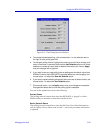
Using the SEHI100TX Hub View
2-18 Monitoring Hub Performance
Multicast Packets
The number of multicast packets received by this device, module, or port since
the window was last opened or reset. Multicast packets are simultaneously
addressed to more than one address, but fewer than all addresses.
Collisions
The number of collisions recorded by this device, module, or port since the
window was last opened or reset. The SEHI100TX counts both receive collisions
Ñ those detected while a port is receiving data Ñ and transmit collisions Ñ those
detected while a port is transmitting data (i.e., the port has transmitted one of the
colliding packets); however, these counts are combined and a single total value is
displayed. Collisions of this type (called ÒlegalÓ collisions, as opposed to the
OOW collisions described below) are a natural by-product of a busy network; if
you are experiencing high numbers of collisions, it may be time to redirect
network trafÞc by using bridges or routers. Extremely high collision rates can also
indicate a data loop (redundant connections) or a hardware problem (some
station transmitting without listening Þrst).
Total Errors
The number of errors of all types recorded by this device, module, or port since
the window was last opened or reset.
Alignment Errors
The number of misaligned packets recorded since the window was last opened or
reset. Misaligned packets are those which contain any unit of bits which is less
than a byte Ñ in other words, any group of bits fewer than 8. Misaligned packets
can result from a packet formation problem, or from some cabling problem that is
corrupting or losing data; they can also result from packets passing through more
than two cascaded multi-port transceivers (a network design which does not meet
accepted Ethernet spec).
CRC Errors
CRC, or Cyclic Redundancy Check, errors occur when packets are somehow
damaged in transit. When each packet is transmitted, the transmitting device
computes a frame check sequence (FCS) value based on the contents of the packet,
and appends that value to the packet. The receiving station performs the same
computation; if the FCS values differ, the packet is assumed to have been
corrupted and is counted as a CRC error. CRC errors can result from a hardware
problem causing an inaccurate computation of the FCS value, or from some other
transmission problem that has garbled the original data. The CRC error counter
shows the total number of CRC errors recorded since the window was last
opened or reset.
OOW Collisions
The number of out-of-window collisions recorded since the window was last
opened or reset. OOW collisions occur when a station receives a collision signal
while still transmitting, but more than 51.2 µsec (the maximum Ethernet
propagation delay) after the transmission began. There are two conditions which
can cause this type of error: either the networkÕs physical length exceeds IEEE


















